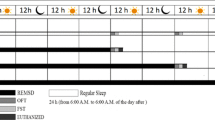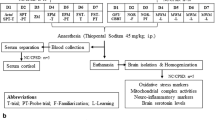Abstract
The pressure to stay up longer in our modern society due to constant exposure to artificial light and interactive activities; furthermore, social and economic pressures impact human physiology and behavior. Rapid eye movement sleep deprivation (REMSD) alters most of the hormones, which may have adverse behavioral changes and other health consequences like mania and other psychiatric disorders. The exact role of REMSD-altered hormonal levels and the manner in which emerging consequences lead to mania-like behavior is poorly understood. Thus, we sought to verify the behavior and endocrinological changes after 48, 72, and 96 h of REMSD-induced mania-like behavior in mice. We performed modified multiple platform method of depriving the REM sleep for 48, 72 and 96 h, respectively, and one group maintained as a control. Motor assessment and aggressive behavior were determined by IR-Actimeter and Resident Intruder Test. Quantitative determination of serum thyroid hormones (TSH, T4, and T3), testosterone, corticosterone (CORT), prolactin (PRL), adrenocorticotropic hormone (ACTH), oxytocin (OT) and melatonin (MT) concentrations were determined by ELISA method. After respective hours of REMSD, the higher locomotion noticed among all REMSD mice and also showed higher aggressive behavior compared with control. Concentration of serum TSH and T4 was declined and elevated the T3, PRL, CORT, testosterone, ACTH, OT and MT levels in REMSD mice. These experiments showed that concentrations for the majority of the studied hormone and behavior were disrupted during REMSD. Our study indicated that REMSD results in mania-like behavior in mice and associated disruption to hormonal levels, although the exact mechanisms by which these take place remain to be determined.







Similar content being viewed by others
References
McNamara P, Capellini I, Harris E, Nunn CL, Barton RA, Preston B. The phylogeny of sleep database: a new resource for sleep scientists. Open Sleep. 2008;J1:11–4.
Hublin C, Kaprio J, Partinen M, Koskenvuo M. Insufficient sleep—a population-based study in adults. Sleep. 2001;24(4):392–400.
Rajaratnam SM, Arendt J. Health in a 24-h society. Lancet. 2001;358(9286):999–1005.
National Health Interview Survey. Quickstats: percentage of adults who reported an average of < 6 hours of sleep per 24-hour period bSaAG-US. Morb Mortal Wkly Rep. 2005; 54: 933.
Harvey AG. Sleep and circadian rhythms in bipolar disorder: seeking synchrony, harmony, and regulation. Am J Psychiatry. 2008;165(7):820–9.
Reiser R, Thompson LW. Bipolar disorder: advances in psychotherapy-evidence-based practice. Cambridge: Hogrefe& Huber Publishers; 2005.
Murray CJ, Lopez AD. The global burden of disease. Geneva: World Health Organization Eds.; 1996; pp. 21–2.
Osby U, Brandt L, Correia N, Ekbom A, Sparen P. Excess mortality in bipolar and Unipolar disorder in Sweden. Arch Gen Psychiatry. 2001;58(9):844–50.
Muller-Oerlinghausen B, Berghofer A, Bauer M. Bipolar disorder. Lancet. 2002;359:241–7.
Kessler L, Nedeltcheva A, Imperial J, Penev PD. Changes in serum TSH and free T4 during human sleep restriction. Sleep. 2010;33:1115–8.
Everson CA, Nowak TS Jr. Hypothalamic thyrotropin-releasing hormone mRNA responses to hypothyroxinemia induced by sleep deprivation. Am J Physiol Endocrinol Metab. 2002;283:E85–E93.
Balzano S, Bergmann BM, Gilliland MA, Silva JE, Rechtschaffen A, Refetoff S. Effect of total sleep deprivation on 5-deiodinase activity of rat brown adipose tissue. Endocrinology. 1990;127:882–90.
Boral GC, Gosh AB, Pal SK, Gosh KK, Nandi DN. Thyroid function in different psychiatric disorders. Indian J Psychiatry. 1980;22:200–2.
Pope HG Jr, Kouri EM, Hudson JI. Effects of supraphysiologic doses of testosterone on mood and aggression in normal men: a randomized controlled trial. Arch Gen Psychiatry. 2000;57(2):133e40.
Su TP, Pagliaro M, Schmidt PJ, Pickar D, Wolkowitz O, Rubinow DR. Neuropsychiatric effects of anabolic steroids in male normal volunteers. J Am Med Assoc. 1993;269(21):2760e4.
Yates WR, Perry PJ, MacIndoe J, Holman T, Ellingrod V. Psychosexual effects of three doses of testosterone cycling in normal men. Biol Psychiat. 1999;45(3):254e60.
Weiss EL, Bowers MB Jr, Mazure CM. Testosterone-patch-induced psychotic mania. Am J Psychiatry. 1999;156(6):969.
Schmidt M, Sofronescu A, Short B, Nahas Z, Zhu Y. Increased prolactin concentrations in a patient with bipolar disorder. Clin Chem. 2013;59(3):473–7.
Andersen ML, Martins PJ, D’Almeida V, Bignotto M, Tufik S. Endocrinological and catecholaminergic alterations during sleep deprivation and recovery in male rats. J Sleep Res. 2005;14(1):83–90.
Mikics E, Kruk MR, Haller J. Genomic and non-genomic effects of glucocorticoids on aggressive behavior in male rats. Psychoneuroendocrinology. 2004;29(5):618–35.
Linkowski P, Geenen V, Kerkhofs M, Mendlewicz J, Legros JJ. Cerebrospinal fluid neurophysins in affective illness and in schizophrenia. Eur Arch Psychiatry NeurolSci. 1984;234(3):162–5.
Kim Y, McGee S, Czeczor JK, Czeczor JK, Walker AJ, Kale RP, Kouzani AZ, Walder K, Berk M, Tye SJ. Nucleus accumbens deep-brain stimulation efficacy in ACTH-pretreated rats: alterations in mitochondrial function relate to antidepressant-like effects. Transl Psychiatry. 2016;6:e842.
Jouvet D, Vimont P, Delorme F, Jouvet M. Study of selective deprivation of the paradoxal sleep phase in the cat. C R Seances Soc Biol Fil. 1964;158:756–9.
Zager A, Andersen ML, Ruiz FS, Antunes IB, Tufik S. Effects of acute and chronic sleep loss on immune modulation of rats. Am J Physiol Regul Integr Comp Physiol. 2007;293(1):R504-9.
Nasir MN, Abdullah J, Habsah M, Ghani RI, Rammes G. Inhibitory effect of asiatic acid on acetylcholinesterase, excitatory post synaptic potential and locomotor activity. Phytomedicine. 2012;19(3–4):311–6.
Meyer N, Jenikejew J, Richter SH, Kaiser S, Sachser N. Social experiences during adolescence affect anxiety-like behavior but not aggressiveness in male mice. Behav Brain Res. 2017;326(9):147–53.
Ghosh PK, Biswas NM, Ghosh D. Effect of lithium chloride on testicular steroidogenesis and gametogenesis in immature male rats. ActaEndocrinol (Copenh). 1991;124:76–82.
Belete H, Mulat H, Fanta T, Yimer S, Shimelash T, Ali T, Tewabe T. Magnitude and associated factors of aggressive behaviour among patients with bipolar disorder at A manual Mental Specialized Hospital, outpatient department, Addis Ababa, Ethiopia: cross-sectional study BMC. Psychiatry. 2016;16(1):443.
Rodrigues NC, da Cruz NS, de Paula Nascimento C, da Conceição RR, da Silva AC, Olivares EL, Marassi MP. Sleep deprivation alters thyroid hormone economy in rats. Exp Physiol. 2015;100(2):193–202.
Boral GC, Gosh AB, Pal SK, Gosh KK, Nandi DN. Thyroid function in different psychiatric disorders. Indian J Psychiatry. 1980;22(2):200–2.
Evans DL, Strawn SK, Haggerty JJR, Garbutt JC, Burnett GB, Pedersen CA. Appearance of mania in drug-resistant bipolar depressed patients after treatment with l-triiodothyronine. J Clin Psychiatry. 1986;47(10):521–2.
Ebinger M, Sievers C, Ivan D, Schneider HJ, Stalla GK. Is there a neuroendocrinological rationale for testosterone as a therapeutic option in depression? J Psychopharmacol. 2009;23(7):841–53.
Franzen PL, Buysse DJ, Dahl RE, Thompson W, Siegle GJ. Sleep deprivation alters pupillary reactivity to emotional stimuli in healthy young adults. Biol Psychol. 2009;80(3):300–5.
Kahn-Greene ET, Lipizzim EL, Conrad AK, Kamimori GH, Killgore WDS. Sleep deprivation adversely affects interpersonal responses to frustration. Personality Individ Differ. 2006;41:1433–43.
Sher L, Grunebaum MF, Sullivan GM, Burke AK, Cooper TB, Mann JJ, Oquendo MA. Testosterone levels in suicide attempters with bipolar disorder. J Psychiatr Res. 2012;46(10):1267–71.
Mattsson A, Schalling D, Olweus D, Löw H, Svensson J. Plasma testosterone, aggressive behavior, and personality dimensions in young male delinquents. J Am Acad Child Psychiatry. 1980;19(3):476 – 90.
Fratta W, Collu M, Martellotta MC, Pichiri M, Muntoni F, Gessa GL. Stress-induced insomnia: opioid–dopamine interactions. Eur J Pharmacol. 1987;3:437–40.
Gessa GL, Pani L, Fadda P, Fratta W. Sleep deprivation in the rat: an animal model of mania. Eur Neuropsychopharmacol. 1995;5:89–93.
Underwood RH, Williams GH. The simultaneous measurement of aldosterone, cortisol, and corticosterone in human peripheral plasma by displacement analysis. J Lab Clin Med. 1972;79:848–62.
Whalley LJ, Christie JE, Blackwood DH, Bennie J, Dick H, Blackburn IM, Fink G. Disturbed endocrine function in the psychoses I: disordered homeostasis or disease process? Br J Psychiatry. 1989;155:455–61.
Torre DL, Falorni A. Pharmacological causes of hyperprolactinemia. Ther Clin Risk Manag. 2007;3(5):929–51.
Riecher-Rossler A, Rybakowski JK, Pflueger MO, Beyrau R, Kahn RS, Malik P, Fleischhacker WW. Hyperprolactinemia in antipsychotic naive patients with first-episode psychosis. Psychol Med. 2013;43(12):2571–82.
Schmidt M, Sofronescu A, Short B, Nahas Z, Zhu Y. Increased prolactin concentrations in a patient with bipolar disorder. Clin Chem. 2013;59(3):473–5.
Morton IK, Hall JM. Concise dictionary of pharmacological agents: properties and synonyms. New York: Springer Science & Business Media. 2012; p. 84.
Valvassori SS, Resende WR, Dal-Pont G, Sangaletti-Pereira H, Gava FF, Peterle BR, Carvalho AF, Varela RB, Dal-Pizzol F. Quevedo J. Lithium ameliorates sleep deprivation induced mania-like behavior, hypothalamic-pituitary-adrenal (HPA) axis alterations, oxidative stress and elevations of cytokine concentrations in the brain and serum of mice. Bipolar Disord. 2017;19(4):246–58.
BelvederiMurri M, Prestia D, Mondelli V, Pariante C, Patti S, Olivieri B, Arzani C, Masotti M, Respino M, Antonioli M, Vassallo L, Serafini G, Perna G, Pompili M, Amore M. The HPA axis in bipolar disorder: systematic review and meta-analysis. Psychoneuroendocrinology. 2016;63:327 – 42.
Geng W, Wu G, Huang F, Zhu Y, Nie J, He Y, Chen L. Sleep deprivation induces abnormal bone metabolism in temporomandibular joint. Int J ClinExp Med. 2015;8(1):395–403.
Carter CS. Oxytocin pathways and the evolution of human behavior. Annu Rev Psychol. 2014;65:17–39.
Turan T, Uysal C, Asdemir A, Kılıç E. May oxytocin be a trait marker for bipolar disorder? Psychoneuroendocrinology. 2013;38:2890–6.
Nurnberger JI Jr, Adkins S, Lahiri DK, Mayeda A, Hu K, Lewy A, Miller A, Bowman ES, Miller MJ, Rau L, Smiley C, Davis-Singh D. Melatonin suppression by light in euthymic bipolar and unipolar patients. Arch Gen Psychiatry. 2000;57(6):572–9.
Kennedy SH, Tighe S, McVey G, Brown GM. Melatonin and Cortisol “switches” during mania, depression and euthymia in a drug free bipolar patient. J Nerv Ment Dis. 1989;177:300–3.
Funding
Department of Science and Technology (DST), INSPIRE division, New Delhi provided financial support as a fellowship (Grant Reference number—DST/INSPIRE/2014/IF140562). The funding source had no involvement in the preparation of the article, study design, analysis, interpretation of data and decision to submit the article for publication.
Author information
Authors and Affiliations
Corresponding author
Ethics declarations
Conflict of interest
The authors declare that there are no conflicts of interest.
Rights and permissions
About this article
Cite this article
Siddique, S.A., Tamilselvan, T., Vishnupriya, M. et al. Evaluation of behavior and endocrinological changes after REM sleep deprivation-induced mania-like behavior in mice. Sleep Biol. Rhythms 16, 375–385 (2018). https://doi.org/10.1007/s41105-018-0166-6
Received:
Accepted:
Published:
Issue Date:
DOI: https://doi.org/10.1007/s41105-018-0166-6




